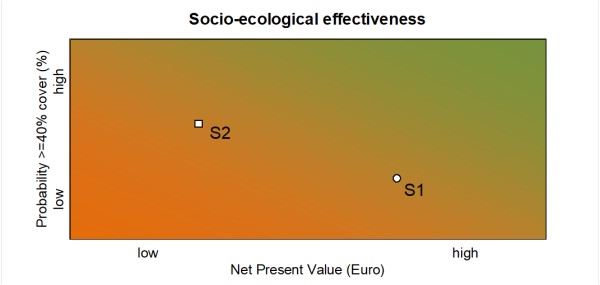| Main authors: | Diana Sietz, Luuk Fleskens, Lindsay C. Stringer |
| Editor: | Jane Brandt |
| Source document: | Sietz, D. et al. (2017) Report on integrated modelling strategy. CASCADE Project Deliverable 8.2 33 pp |
»Step 2: Assessing ecological impacts of land management and »Step 3: Estimating economic impacts of land management served to determine ecological and economic impacts for particular types of ecosystems and a set of management scenarios (see »Step 1: Defining managment scenarios). In this step, ecological and economic insights are integrated to evaluate the socio-ecological effectiveness of management. This evaluation is based in the following criteria:
- If a management scenario is effective in preventing or reversing degradation (i.e. high probability ≥40% cover) and its NPV is high, it is effective in socio-ecological terms and likely to be attractive to land users and policy makers.
- A management scenario that effectively prevents or reverses degradation (i.e. high probability ≥40% cover) but has a negative or low NPV (e.g. S2 in Figure 1) indicates that policy incentives such as subsidies would be useful to increase land users’ motivation to implement this type of management.
- If a management scenario yields high NPV but cannot effectively prevent degradation (i.e. low probability ≥40% cover; e.g. S1 in Figure 1), it would seem acceptable only from a profit-maximisation perspective that focusses on short-term goals. However, such a scenario does not contribute to sustainable land management.
- If both NPV and degradation prevention effectiveness are low, a management scenario is socio-ecologically ineffective and should also be disregarded in efforts aimed at achieving sustainable land management.

Figure 1
This socio-ecological evaluation together with the modelled vegetation dynamics and economic findings was discussed with stakeholders at regional workshops to test the robustness of findings in particular regional contexts. Potential disagreement between the findings of this modelling strategy, field observations and land users’ as well as decision-makers’ experience were explored and can lead to refinements in the ecological and economic assessments. The results can be found in »Multi-scale evaluation with policy makers.
Finally, the evaluation of socio-ecological effectiveness of land management can be up-scaled to a regional level representing the Mediterranean drylands in southern Europe. This requires capturing the full range of environmental conditions and livestock density observed in Mediterranean drylands. Suitable spatially-explicit indicators include aridity index (Trabucco and Zomer 2008) and livestock density data (Robinson et al. 2014) available at high-resolution for the Mediterranean region (Figures 2 and 3). Other indicators may deliver complementary information on environmental conditions such as soil quality data such as organic carbon content (ESDB 2004, Jonas et al. 2005, Panagos et al. 2012) and land cover (e.g. CORINE land cover).

Figure 2

Figure 3
The gradients of observed environmental conditions are assumed to be reflected by the 0-1 parameter scale (i.e. min-max values) used to determine the respective parameter (i.e. b) in the rangeland resilience model. In future up-scaling, the observed livestock density will be converted to the livestock density parameter used in the model based on reference conditions (i.e. vegetation cover) without livestock grazing. All potential combinations of environmental conditions (i.e. based on aridity index and soil organic carbon content) and grazing pressure (i.e. livestock density) will be used as starting conditions to model ecological management impacts (i.e. vegetation cover). Model parameters such as local facilitation and competition will be adjusted reflecting particular ecological processes and feedbacks. According to the specifications of management scenarios, vegetation cover will be modelled over 10 years.

Figure 4
Differences in vegetation cover dynamics directly translate into differences in the costs that arise to purchase supplementary fodder depending on the price of fodder. The fodder price is therefore the most important economic aspect differentiating the financial viability (i.e. net present value) among the management scenarios. Hence, a gradient of fodder price is considered to capture variations in economic management impacts. This gradient is informed by fodder prices reported for Mediterranean countries (Eurostat, 2017). Taken together, the combined gradients of environmental conditions, livestock density and fodder price constitute the basis for evaluating socio-ecological effectiveness at a regional scale considering the evaluation criteria outlined above. An example output is given displaying the vegetation cover that results from two management scenarios applied along gradients of environmental conditions and livestock density (Figure 4).
Note: For full references to papers quoted in this article see
